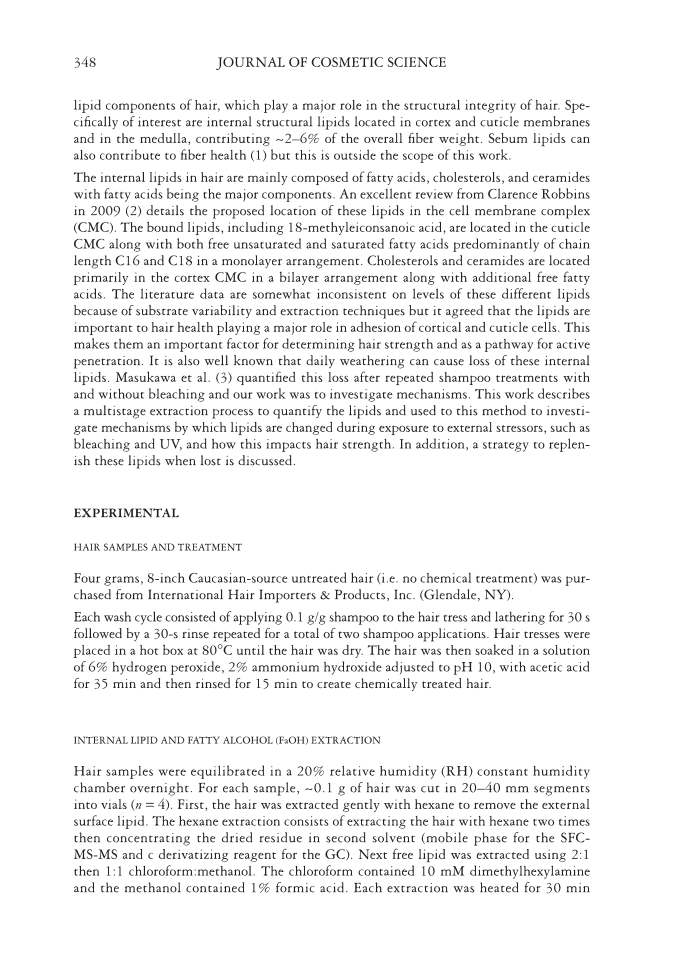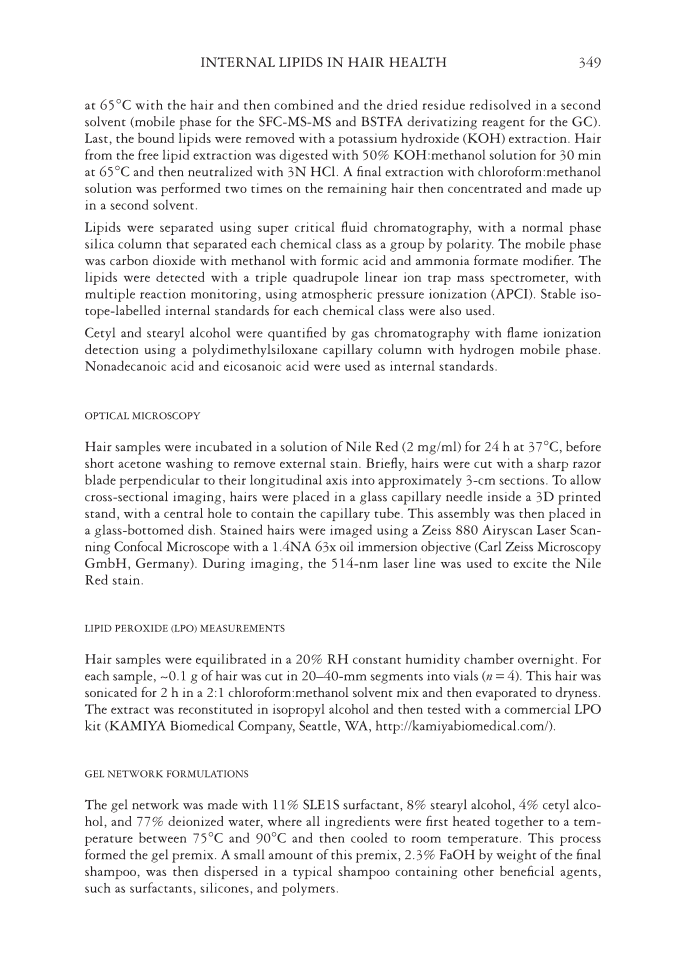JOURNAL OF COSMETIC SCIENCE 348 lipid components of hair, which play a major role in the structural integrity of hair. Spe- cifi cally of interest are internal structural lipids located in cortex and cuticle membranes and in the medulla, contributing ~2–6% of the overall fi ber weight. Sebum lipids can also contribute to fi ber health (1) but this is outside the scope of this work. The internal lipids in hair are mainly composed of fatty acids, cholesterols, and ceramides with fatty acids being the major components. An excellent review from Clarence Robbins in 2009 (2) details the proposed location of these lipids in the cell membrane complex (CMC). The bound lipids, including 18-methyleiconsanoic acid, are located in the cuticle CMC along with both free unsaturated and saturated fatty acids predominantly of chain length C16 and C18 in a monolayer arrangement. Cholesterols and ceramides are located primarily in the cortex CMC in a bilayer arrangement along with additional free fatty acids. The literature data are somewhat inconsistent on levels of these different lipids because of substrate variability and extraction techniques but it agreed that the lipids are important to hair health playing a major role in adhesion of cortical and cuticle cells. This makes them an important factor for determining hair strength and as a pathway for active penetration. It is also well known that daily weathering can cause loss of these internal lipids. Masukawa et al. (3) quantifi ed this loss after repeated shampoo treatments with and without bleaching and our work was to investigate mechanisms. This work describes a multistage extraction process to quantify the lipids and used to this method to investi- gate mechanisms by which lipids are changed during exposure to external stressors, such as bleaching and UV, and how this impacts hair strength. In addition, a strategy to replen- ish these lipids when lost is discussed. EXPERIMENTAL HAIR SAMPLES AND TREATMENT Four grams, 8-inch Caucasian-source untreated hair (i.e. no chemical treatment) was pur- chased from International Hair Importers & Products, Inc. (Glendale, NY). Each wash cycle consisted of applying 0.1 g/g shampoo to the hair tress and lathering for 30 s followed by a 30-s rinse repeated for a total of two shampoo applications. Hair tresses were placed in a hot box at 80°C until the hair was dry. The hair was then soaked in a solution of 6% hydrogen peroxide, 2% ammonium hydroxide adjusted to pH 10, with acetic acid for 35 min and then rinsed for 15 min to create chemically treated hair. INTERNAL LIPID AND FATTY ALCOHOL (FaOH) EXTRACTION Hair samples were equilibrated in a 20% relative humidity (RH) constant humidity chamber overnight. For each sample, ~0.1 g of hair was cut in 20–40 mm segments into vials (n = 4). First, the hair was extracted gently with hexane to remove the external surface lipid. The hexane extraction consists of extracting the hair with hexane two times then concentrating the dried residue in second solvent (mobile phase for the SFC- MS-MS and c derivatizing reagent for the GC). Next free lipid was extracted using 2:1 then 1:1 chloroform:methanol. The chloroform contained 10 mM dimethylhexylamine and the methanol contained 1% formic acid. Each extraction was heated for 30 min
INTERNAL LIPIDS IN HAIR HEALTH 349 at 65°C with the hair and then combined and the dried residue redisolved in a second solvent (mobile phase for the SFC-MS-MS and BSTFA derivatizing reagent for the GC). Last, the bound lipids were removed with a potassium hydroxide (KOH) extraction. Hair from the free lipid extraction was digested with 50% KOH:methanol solution for 30 min at 65°C and then neutralized with 3N HCl. A fi nal extraction with chloroform:methanol solution was performed two times on the remaining hair then concentrated and made up in a second solvent. Lipids were separated using super critical fl uid chromatography, with a normal phase silica column that separated each chemical class as a group by polarity. The mobile phase was carbon dioxide with methanol with formic acid and ammonia formate modifi er. The lipids were detected with a triple quadrupole linear ion trap mass spectrometer, with multiple reaction monitoring, using atmospheric pressure ionization (APCI). Stable iso- tope-labelled internal standards for each chemical class were also used. Cetyl and stearyl alcohol were quantifi ed by gas chromatography with fl ame ionization detection using a polydimethylsiloxane capillary column with hydrogen mobile phase. Nonadecanoic acid and eicosanoic acid were used as internal standards. OPTICAL MICROSCOPY Hair samples were incubated in a solution of Nile Red (2 mg/ml) for 24 h at 37°C, before short acetone washing to remove external stain. Briefl y, hairs were cut with a sharp razor blade perpendicular to their longitudinal axis into approximately 3-cm sections. To allow cross-sectional imaging, hairs were placed in a glass capillary needle inside a 3D printed stand, with a central hole to contain the capillary tube. This assembly was then placed in a glass-bottomed dish. Stained hairs were imaged using a Zeiss 880 Airyscan Laser Scan- ning Confocal Microscope with a 1.4NA 63x oil immersion objective (Carl Zeiss Microscopy GmbH, Germany). During imaging, the 514-nm laser line was used to excite the Nile Red stain. LIPID PEROXIDE (LPO) MEASUREMENTS Hair samples were equilibrated in a 20% RH constant humidity chamber overnight. For each sample, ~0.1 g of hair was cut in 20–40-mm segments into vials (n = 4). This hair was sonicated for 2 h in a 2:1 chloroform:methanol solvent mix and then evaporated to dryness. The extract was reconstituted in isopropyl alcohol and then tested with a commercial LPO kit (KAMIYA Biomedical Company, Seattle, WA, http://kamiyabiomedical.com/). GEL NETWORK FORMULATIONS The gel network was made with 11% SLE1S surfactant, 8% stearyl alcohol, 4% cetyl alco- hol, and 77% deionized water, where all ingredients were fi rst heated together to a tem- perature between 75°C and 90°C and then cooled to room temperature. This process formed the gel premix. A small amount of this premix, 2.3% FaOH by weight of the fi nal shampoo, was then dispersed in a typical shampoo containing other benefi cial agents, such as surfactants, silicones, and polymers.
Purchased for the exclusive use of nofirst nolast (unknown) From: SCC Media Library & Resource Center (library.scconline.org)









































































































